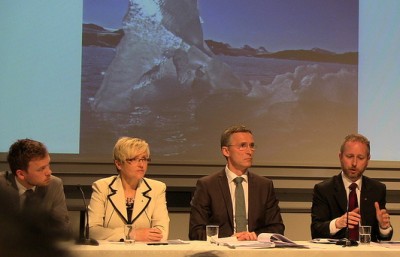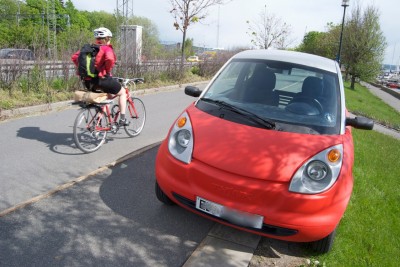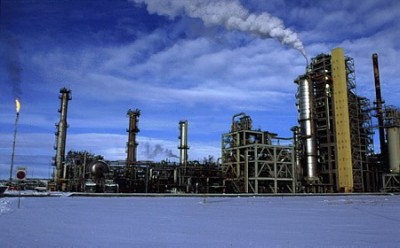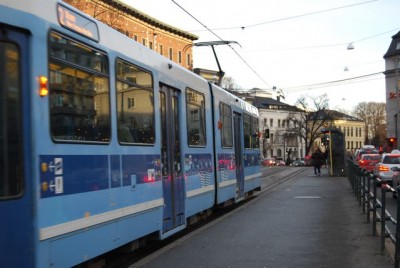NEWS ANALYSIS: After months, even years of delays, Norwegians have now been handed the most comprehensive climate report ever compiled by their government on how they’ll be asked to cut carbon emissions. Environmental activists, opposition politicians and some researchers, however, warned it won’t meet its own ambitious goals, and puts off the tough and expensive measures that are really needed.

Election researchers Hanne Marthe Narud and Anders Todal Jenssen, for example, said the report was full of compromises and likened it to “ostrich politics:” Politicians eager to show they’re “doing something” about Norway’s need to cut emissions at home, but putting their heads in the sand by presenting proposals that won’t be implemented for years to come.
Norway’s left-center three-party coalition government did get credit for finally agreeing at least enough to get the report out. It calls for all sectors of society, from industry to housing to transport, to take their share of emission cuts. The report, called klimeldingen in Norwegian, also calls for establishment of a new “climate and energy fund” to help finance new technology aimed at reducing emissions.
The government’s report also proposes doubling the C02 fees placed on the oil industry. Prime Minister Jens Stoltenberg of the Labour Party also stressed the need for more use of public transport through measures that will further discourage use of private cars in Norway, a country where fuel is already heavily taxed as are most other aspects of driving from the price of vehicles to road tolls and high car registration fees. Norwegians are currently paying more than USD 11 a gallon for unleaded gas at the pump, most of it through punitive taxes.

Stoltenberg urged more Norwegians to ride bicycles to work, something Crown Princess Mette-Marit, in a case of remarkable timing, had done herself in a palace-organized event to which the media were invited on the day before the climate report was released. Stoltenberg also repeated how his government was providing more funding than ever for improvements to trains and other modes of public transit.
Finally, in a concession to the government’s rural-oriented Center Party, the report called for more tree-planting around Norway and said that it would be used in the calculations for emission reduction because of the positive effect trees can have on CO2.
Several Norwegian newspapers claimed that Labour had made concessions to SV on many issues, in an effort to keep the left-center coalition together. Newspaper Dagsavisen even headlined that Labour had sided with SV over its traditionally most important supporter, trade union confederation LO and other unions keen to relieve industry of climate-cut expenses in order to preserve jobs. LO boss Roar Flåthen had issued yet another warning to Stoltenberg just in the past week, but Stoltenberg went along with SV’s demand that fully two-thirds of Norway’s emission cuts will still be made at home in Norway. LO favours paying for cuts outside the country, that would give climate credit to Norway.

There’s been a lot of political intrigue behind the government coalition’s report, however, and industry was nonetheless relieved after its presentation on Wednesday, simply because many industrial leaders don’t think the government’s ambitious measures will ever be fully implemented. The tough and expensive measures needed to really cut emissions, like demands for carbon capture facilities or even closure of some plants, would have strangled Norwegian industry and were therefore left out of the report. LO’s Flåthen seemed satisfied and Stoltenberg admitted that the costs of carbon capture, such as the much-hyped but delayed facility at Statoil’s Mongstad plant, had “unfortunately become much higher” since he boasted of what he called “Norway’s moon landing” several years ago. The landing is far from on schedule.

Stoltenberg’s government has played an active role in international efforts to cut emissions and it’s thus important for it to practice what it preaches at home. Environmentalists, however, weren’t nearly as relieved as industry, and skepticism ran high. Frederic Hauge of Bellona said he was glad that two-thirds of the cuts needed for Norway to reduce total emissions by 30 percent by 2020 will still be taken at home. And taking steps at home instead of just buying Norway’s way out of the cuts was “a big victory,” he said.
But neither he nor his counterparts in other organizations think the measures are ambitious enough, and several don’t think they’ll provide enough cuts. Nina Jensen, secretary general of Norway’s chapter of WWF, said “we can’t keep shoving this ahead of us” and that more concrete measures were needed. Hauge agreed. “There will have to be many fewer cars on the road for all the emission cuts needed,” he said.
Others quickly pointed out that public transit systems are already heavily used and about to burst their capacity. It’s one thing to force Norwegians out of their cars and over to trams or trains, but there must be enough capacity to allow them on board. That indicates massive investment will be needed in expanding local and regional systems.
The oil and gas sector will arguably need to cut emissions most because it accounts for a quarter of them in the entire country. A near doubling of carbon fees, to NOK 420 per ton of CO2, is aimed at handing an economic incentive to oil companies to cut emissions and, for example, for oil fields to use more electricity from land instead of energy from gas power plants. Statoil said the higher fees will cost it around NOK 1 billion every year, and it has promised to cut emissions, along with the rest of the industry, by a million tons by 2020.
Meanwhile, though, a top Statoil executive told newspaper Dagens Næringsliv (DN) that the company’s faith in its controversial oil sands project in Canada had grown stronger, and that it was considering expanding its operations in Alberta. They amounted to “good business,” Lars Christian Bacher, head of Canada operations, told DN. “We have already managed to cut costs, improve profitability and reduce CO2 emissions from the project.” Oil sands projects have earlier been described as among the most environmentally harmful in the industry, and opposition to Statoil’s participation remains high, also in Norway.
Views and News from Norway/Nina Berglund
Please support our stories by clicking on the “Donate” button now:

